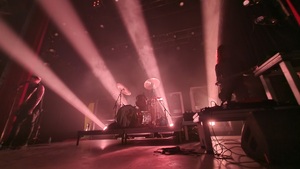Euro-Improv and the Spirit of Jazz
by Bob Pomeroy
The Palladium Theater in downtown St. Petersburg was once a church. Now converted into a performance space, the room still has the aura of a sanctuary. Organ pipes can be seen rising up at the rear of the stage. The high ceilings and architectural flourishes still suggest something sacred. On a rainy Friday night in early June, two heavyweights of the European improvised music scene mounted the stage at the Palladium and illuminated how improvised music shares the spirit of jazz while often doing something a little (or a lot) different.
The duo of Fred Van Hove and Johannes Bauer were promoted as an Avant-Garde jazz duo. This is truthful in that both Bauer and Van Hove have played with people like Peter Brotzmann and Cecil Taylor. The sort of improvised music these guys play has little or nothing to do with smooth jazz and the hard bop that people hear on Tampa area jazz radio. Some people were not prepared for what they heard!
Fred Van Hove, is a muscular pianist. His rapid fire pace and intricate patterns are suggestive of a more restrained Cecil Taylor. Then, just when you’re getting used to the Monk on amphetamine play, he starts putting rubber balls and other objects on the strings. Suddenly we’ve veered from out there jazz to John Cage experimentalism. Johannes Bauer is a trombonist unlike any I’ve seen
before. A good deal of what Bauer played were vocalizations and breath sounds projected through his horn. When he did play notes, they could be almost too soft too hear or so loud that they splatter against the back wall and bounce back. At the break, about half the audience left looking bewildered. The rest of us were really digging the sounds.
Let me stress that point; we were digging the SOUNDS. Fred Van Hove and Johannes Bauer were playing with sound and acoustics. They often dispensed with traditional notions of melody and harmony, moving into territory explored as often by contemporary experimental composers working in the classical tradition as jazz players. I can’t say how much of what Van Hove and Bauer played was jazz inspired. I can affirm that what they played pushed at the edges of several traditions and obscured whatever lines separated them. Some of us really liked being challenged, others didn’t.
Between the Lines is a new German label who are right up front about the fact that the music they release plays in the gray area between genres. Austrian trumpeter and composer Franz Koglmann offers a fine example of the label’s genre defying spirit with his release, Make Believe. The disc is a musical score based on Jean Cocteau’s novel “Les Enfants Terribles.” Koglmann begins the disc with a deconstruction of the Jerome Kern composition, “Make Believe,” which Cocteau cited as an inspiration for his novel. Koglmann uses this standard as both a structure for improvisation and to set up the compositions that follow.
“Make Believe” sounds like fragments from a dream in which a jazz band is playing. Recognizable phrases are hear, only to slip away. The jazz band morphs into a chanber orchestra and then a rock band makes it’s presence known. As we move beyond, Koglmann’s compositions become more evocative and less linear. The music is structured, yet disorienting as befits the dug-influences altered states which fueled Cocteau’s original work. “Rue Montmartre” comes across as a fractured Henry Mancini detective movie theme. This is all as it should be in a musical without actors or lyrics.
Michel Wintsch takes his group Road Movie down some similarly abstract paths as Koglmann. Both composers works incorporate jazz as the foundation for their music while freely drawing on other traditions. Wintsch’s group mirrors a small chamber orchestra. Violins and cello play against trumpet and trombone. Piano and flute play off a pair of drummers. I can only guess what contribution Jean Keraudren makes since he is credited only with “sound.”
Wintsch considers himself a dreamer and his compositions have a dreamlike quality. At times, it sounds like Wintsch has written a lush score, then takes away half the parts. At other times, we’re treated to a fully realized and fully fleshed out score. The disc progresses like the proverbial road movie. We’re given sonic impressions of different landscapes as we pass by. Wintsch uses his broad knowledge of musical genres to give each piece a distinctive timber, color and character.
European improvisers like Fred Van Hove, Michel Wintsch, Franz Koglmann and Johannes Bauer are definitely inspired by the spirit of jazz. Unlike some of their American contemporaries, these European players feel no need to be true to jazz conventions. As Koglmann put it, “in Europe there has been no cultural battles over the black or white ‘ownership’ of jazz – since the jazz tradition had always been second hand for European musicians anyway.” Freed from any imperative to be “true” to the jazz tradition, European improvisers have felt free to explore connections between the jazz spirit of improvisation and other traditions. The musicians highlighted here definitely play jazz, but it’s a jazz that is inspired as much by John Cage as John Coltrane and Enrico Morricone as Theloneous Monk. On the surface, the music may not have much in common with Duke Ellington. Deep down, it shares the spirit of creativity and exploration that has kept jazz alive all these years.












